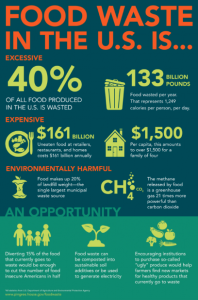Did you know that Americans waste about 40% of their food, while 14.3% of American households are food insecure? The USDA Economic Research Service defines food waste as “the component of food loss that occurs when an edible item goes unconsumed, as in food discarded by retailers due to color or appearance and plate waste by customers”. It is difficult to point fingers at who is causing the high percentage of food waste since it is a combination of farms, restaurants, homes, fishing boats, packaging houses, manufacturing facilities, transportation and retail businesses. Here is a little more information on food waste from farms, restaurants and homes.
Farms:In the United States, six billion pounds of fresh produce is left in the fields by farmers. This is because farms have to create more than the consumer demand to prepare for bad weather, disease and pests. Farmers throw away about 1/3 of their harvest due to strict retailer and consumer standards. Often, the “ugly” produce that is not the correct color, size, weight or has blemishes won’t make it to the retailer.
Restaurants:As

a waitress, I see so much food get wasted, both on the restaurant and customer sides. As someone who loves to go out to eat, I get so excited when I see a big plate of food coming my way, but often, my eyes are bigger than my stomach. A study done at Cornell University found that customers leave 17% of their meals uneaten, and 55% of potential edible leftovers are left at the restaurant. What I enjoy doing when going out to eat is to share a bigger entrée and a smaller one (salad or appetizer) with the person I am with. This way, we are more likely to eat all the food that was given to us.
At home: About two-third
s of food wasted at home is due to not eating if before it reaches the expiration date. Sometimes, I get so excited to make a new recipe that I buy the ingredients, and then a few days later, I forget about it (I try not to do this). average US household wastes $1,365-$2,275 per year by throwing away food which is about 25% of the food that we buy. Wasting food= Wasting money.
What happens to the food waste?
The majority of the food waste ends up in the landfill. When food goes to landfill, it breaks down to form a greenhouse gas called methane, which is 25x worse than carbon dioxide! Luckily, there are several things that you can do to not waste food!
Compost: Composting is a great way to reduce your food waste, and it will also make your garden much healthier. If you don’t have a garden but are still interested in composting, Mr. Fox (available in NH And ME) is a composting service that provides you with compost liners and picks it up, and in return, you get a bag of compost in the spring.
Buy what you need: Shop carefully! Making a grocery list with the exact quantity you will help keep you on track and keep you from buying too much. Try a new recipe that uses the “unwanted” parts of
a veggie such as the broccoli stalks or beet greens. Sometimes it is best to shop for only the next 2-3 days so that you can stick to your food schedule more accurately.
Eat leftovers: Making too much food shouldn’t mean that it gets sent to the landfill. Leftovers make a great lunch for the next day or an easy meal for the week. Isn’t it the best to warm up some leftovers for dinner? You can even cook with leftovers in mind– using ingredients and recipes that are easily recycled into multiple meals. Leftover rice? Sounds like a stir fry! Leftover protein? Sounds like a great salad topper!
Freeze:Save your fresh produce and leftovers in the freezer! If you don’t think you will eat those blueberries or broccoli, the freezer is a good home for them until you want them. You can also consider different kinds of food preservation such as dehydrating or canning.
Shop Farmers’ Markets and Farm Stands: A lot of waste happens when industrial farms sell to large grocery store chains– there is a lot of product lost in transportation and storage, not to mention product that never leaves the farm because it doesn’t meet strict “quality” and congruency standards. At farm stands and markets, you can often find vegetable “seconds” — slightly imperfect but equally nutritious/fresh food. Learn to accept a little imperfection from your fruits and veggies and you’ll be a step closer to saving the planet!
http://www.sustainabletable.org/5664/food-waste
Picture: https://pingree.house.gov/foodwaste
